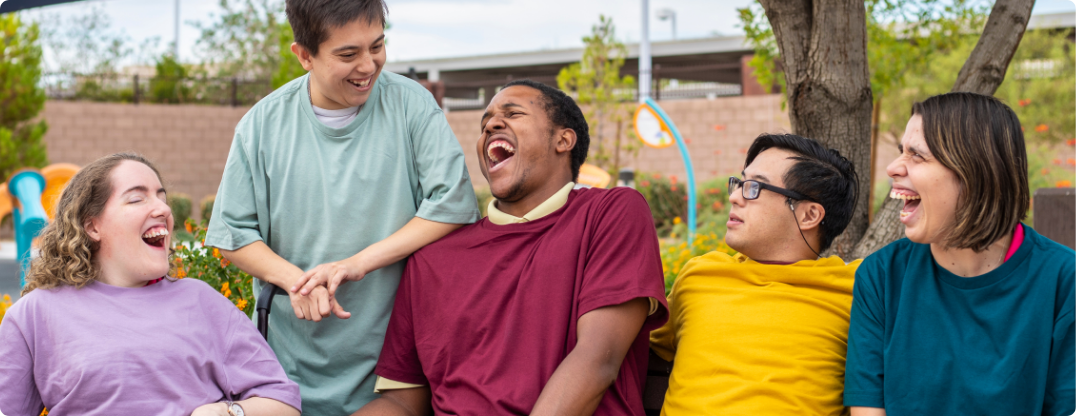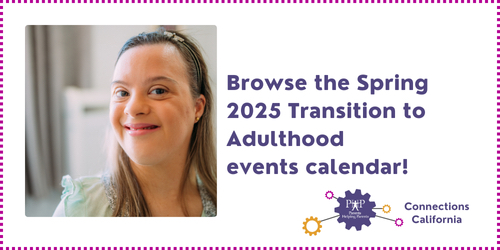It is never too early or too late to think about life beyond high school. Start transition planning for teens and tweens as early as middle school!
There are several options for high school students and their families to learn about and consider. Transition planning for teens and tweens is an essential part of a successful adult outcome. Read on or click a topic below and jump to that information.
High School Diploma
High School Equivalency Certificate
Certificate of Completion
504 Plans
Individual Transition Plan (ITP)
Regional Occupational Centers and Programs (ROCP)
California Department of Rehabilitation

High School Diploma
The most common choice is a traditional High School Diploma. This involves passing a specific set of courses and obtaining enough units. Planning on attending college, either for a 2- or 4-year degree? A diploma is required. Trade schools that are offered through community colleges, and many jobs, also require a high school diploma. What about the military? They also generally require a high school diploma, although they do accept a small number of recruits with a high school equivalency certificate. Check with your school district as to whether alternative, or new, pathways to diploma have been explored
High School Equivalency Certificate
This option can be achieved by passing one of two tests approved by California, the GED, and HiSET. The student must be 17 or 18 years of age to take it. Many adult education programs offer courses to help prepare students for these tests. This can be a good choice for those interested in going into a trade school, and/or who have struggled in the traditional high school environment.
Certificate of Completion
Some students with disabilities will receive a Certificate of Completion when leaving high school. The certificate is for those who have not passed a set of specific courses to make them eligible to receive a diploma. These students typically have an IEP and may choose to go into a public or private post-secondary school program until age 22. They can continue to work on their transition to adulthood goals included in their Individual Transition Plan (ITP). They can even work toward receiving a diploma if they choose to do so.
504 Plans
Students with 504 plans don’t have the same right to school-based transition plans that students with IEPs have. 504 plans do not have the equivalent of an ITP. Some school districts may provide transition planning for students with 504 plans, even though they’re not required to do so. But this doesn’t happen in all districts. See Understood.org’s Can a Student with a 504 Plan Get a Transition Plan? for more.
Another service to explore for transition planning for teens and tweens – and for students with 504 plans and IEPs – is the California Department of Rehabilitation (DOR).
Individual Transition Plan (ITP)
According to The Individuals with Disabilities Education Act – (IDEA) – every student with an IEP must have an Individual Transition Plan (ITP) in their IEP by the time they turn 16. The ITP is a written document designed to help prepare students for life after school. The best practice is to begin talking about transition planning in middle school when the student is 12 or older.
Transition planning for teens and tweens can take place during annual IEP meetings. Transition planning can also be held independently of the annual meeting, at a separate transition IEP meeting. The focus of an independent transition planning meeting includes assessment results, goals, activities, community experiences, related services, and the student’s desires and preferences.
It may be more appropriate to combine the meetings in middle school, depending on the student’s desires and the team’s opinion. It may be beneficial to have separate meetings with high school students to allow more time to focus on the transition planning, especially in the last couple of years. The ITP will be incorporated into the student’s existing IEP at the transition meeting.
Transition planning in high school may also cover:
- Review of coursework/credits – on track for graduation? (If applicable)
- Services needed to get ready for education or training after high school.
- Potential public and/or private post-secondary transition programs
- Discussion of workplace readiness
- Input from outside agencies involved in the student’s transition planning goals.
Outside agencies may be invited to the IEP transition meeting if approved by the student (if 18 or over) and/or the parent. Agencies invited to the transition IEP meeting could include any agency which will aid in the student’s transition to adulthood (examples: Regional Center, Department of Rehabilitation).
Building a robust ITP, with the student’s input, will go a long way to helping them achieve success as they transition to adulthood.
The Individualized Transition Plan (ITP):
- Outlines 3 main transition goals:
- Education or training | Employment | Independent living (whichever is most applicable
- Community experiences and activities
- Related services
- Maps out short and long-term adult outcomes. The student and the student’s IEP team determine these outcomes together. Annual goals and objectives are defined based on these short and long-term adult outcomes.
- Should have transition assessments that evaluate the student’s abilities and strengths and uncover desires for the student’s future in the 3 main goal areas.
- Should also include specific goals and activities based on their post-high school plans:
- Want to attend college and needs to learn about college accommodations? That should be in the ITP plan.
- Want to be a dog sitter? Services and supports to meet that goal should be in the ITP.
Review sample transition plans offered by Understood.org, VIEW, to get ideas for building something appropriate and actionable while working with your IEP team. See Matrix Parent Network’s ITPs: The Sequence to learn how to build a robust ITP.
Whatever path a high school student is on, please know that if they are struggling, there is still time to help them be successful! Alternative high school programs, or additional supports and services, such as assistive technology, may be available. Both the IEP and a 504 document can include support and services to improve high school success.
Regional Occupational Centers and Programs (ROCP)
Regional Occupational Centers and Programs (ROCP) in California that provide career technical education (CTE) and training to high school students and adults. These centers and programs are overseen by the California Department of Education (CDE) and are intended to prepare students for the workforce by offering a variety of vocational courses and hands-on training so that students can:
- Enter the workforce with skills and competencies to be successful
- Pursue advanced training in postsecondary educational institutions
- Upgrade existing skills and knowledge
The main objectives of ROCPs in California include:
- Career Preparation: ROCPs offer a wide range of career-focused courses and programs with local workforce needs in mind.
- Hands-On Learning: Centers emphasize practical learning experiences so that students acquire real-world skills in their chosen fields, building practical expertise and confidence.
- Industry Partnerships: ROCPs often collaborate with local businesses, industries, and trade organizations to develop curriculum, provide internship opportunities, facilitate job placements, and provide training that is relevant to the current job market.
- High School Integration: ROCPs work closely with local high schools to offer CTE courses as part of the regular school curriculum. This allows high school students to explore vocational pathways while earning credits toward their high school diplomas.
- Adult Education: In addition to serving high school students, ROCPs serves adults seeking to acquire new skills or transition to different career paths.
Examples of these programs include:
- Certified Nurse Assistant/Home Health Care Aide (CNA/HCA)
- Automotive Youth Education Systems Programs (AYES)
- ROCP California Work Opportunity and Responsibility to Kids (CalWORKs)
- SkillsUSA California
Find information about CA’s 74 ROCPs and participating school districts.
California Department of Rehabilitation
Does the student want to be employed during or after they leave high school?
The Department of Rehabilitation (DOR) works with many school districts in a Transition Partnership Program (TPP). Statewide, over 100 school districts work with DOR to provide services. These services include job preparation, job development, and short-term support services. The goal of DOR is to successfully help students with disabilities transition into meaningful employment.
DOR’s Student Services Program provides pre-employment skills services for students between the ages of 16-21 years old:
- Job exploration – Learn about different kinds of jobs and which ones are best for each student:
- Explore and discuss career interests
- Learn about the job market – skills needed and pay options
- Find out what jobs lead to better jobs
- Discover what jobs could be right for you
- Understand what you need to do to get the career you want
- Postsecondary counseling – Learn about enrolling in education and training programs that support career goals:
- Explore education – college, technical, and trade schools
- Learn about the admissions process
- Discover resources to promote successful outcomes in school and at work
- Identify options to help pay for school
- Get support in completing the financial aid application
DOR counselors may help with transition planning for employment – including what the student needs to accomplish to become employed – like attending a 2- or 4-year college. They may create an Individualized Plan for Employment and work with clients on their employment goals, providing services and support to assist in meeting those goals. Please see the Student and Youth section on DOR’s website for more information.









